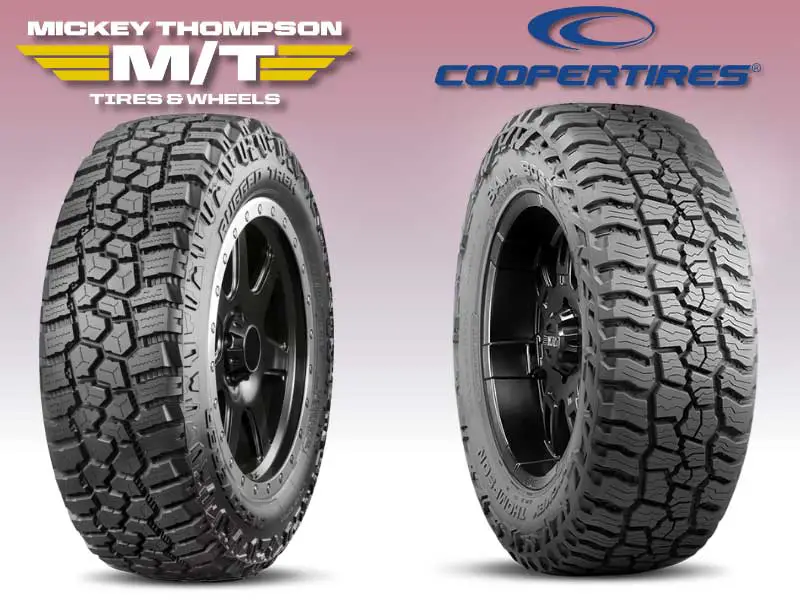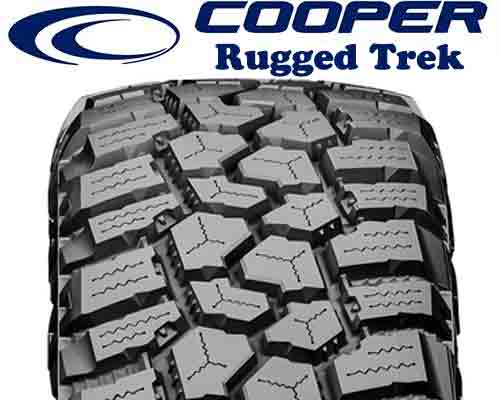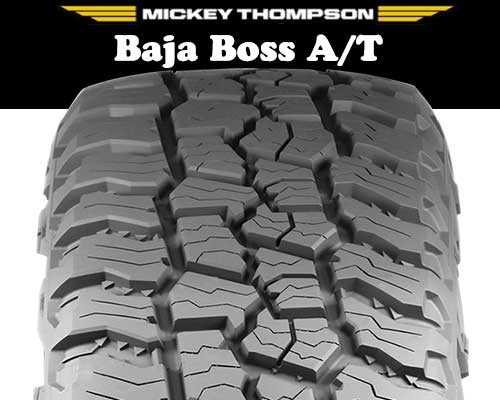Aggressive all-terrain tires like the Mickey Thompson Baja Boss A/T and the Cooper Rugged Trek play a pivotal role, when it comes to challenging terrains. They are the perfect blend of all-terrain (A/T) and mud-terrain (M/T) tires, combining the best of both worlds.
That’s why they are called hybrids, besides having having another name, Rugged Terrains. They simply put offer better pavement performance compared to mud terrains, while their off-road capabilities is superior to average all-terrain (A/T) tires.

Let’s check out their sizes before moving on towards their designs.
| Dimensions | Cooper Rugged Trek | Mickey Baja Boss A/T |
|---|---|---|
| Total Sizes | 18 | 59 |
| Rim Sizes Range | 16″ to 20″ | 15″ to 24″ |
| Speed Ratings | T, Q | Q, T |
| Load Ratings | SL, XL, E, F | SL, XL, D, E, F |
| Weight Range | 40 lbs to 70 lbs | 36 lbs to 90 lbs |
| Tread Depth | 16/32″ or 18.5/32″ | 16/32″ or 18.5/32″ |
| 3PMSFR | Yes | Yes |
| Warranty | 55k miles for LT sizes 65k miles for others | 60k miles for non-LT sizes 50k miles for LT sizes |
Table of Contents
Design Features
When looking at them, you can’t help but notice a lot of similarities between the two tires. And then it makes sense to know that both of these tires are part of a same company. Cooper. Though Cooper was bought by Goodyear.
Let’s check these tires out, starting with the Cooper Rugged Trek. So this tire distinguishes itself with its unique elongated sidewall lugs.

These lugs are embedded with notches/biters, which improve the tire’s traction during off-road, especially with lowered air pressures.
Its aggressive, staggered shoulder lugs are structured with full-depth interlocking sipes, (forming a wave-like pattern), adding both aesthetics and decent functionality overall.
And as you may have noticed, the wide gaps of the shoulder voids are filled with stone ejectors, and they have ridged/shoulder connectors placed in between. Cooper calls it whiper grooves. I’ll talk about it more in noise section.
In the middle there are randomly shaped blocks, with snow vices on their outer margins and off-set edges in all directions.
These lugs carry Y shaped sipes, and have solid reinforce foundations underneath.
Moreover they also form interconnected web of grooves running in all directions.
The Mickey Thompson Baja A/T, on the other hand, presents a more aggressive approach to its sidewall lug design.

These lugs provide exceptional lateral traction, a feature that becomes particularly beneficial on rocky terrains, as you’d see in the respective section.
While the tire lacks staggered shoulder lugs, each block has sharp traction notches on the outer edges, which still offer quite some grip.
The elongated lateral voids between these shoulder lugs have ton of stone ejectors, and these voids, then connect with even wider circumferential grooves, which separates the tire’s central area.
Speaking of which in the middle there are two ribs, where on one, there are lateral and longitudinal notches, and on the other, there are other similar features such as interlocking sipes, and sharp off-set edges.
Because of the differences in these two ribs, the overall tire design falls in the category of asymmetric structure.
Durability
Off-road tires must be sturdy and resistant enough to withstand some of the puncturing terrains out there such as rocks. And Mickey Thompson A/T is the best one for the job.
The tire is one of the toughest you can find in the R/T and A/T category, (even tougher than KO2), as it features a 3 ply polyester casing protecting the thick sidewall lugs. Additionally, the tire features two cap plies of nylon and steel belts, further enhancing its durability.
On the other hand, the Cooper Rugged Trek, while offering a decent two-ply polyester casing, falls a bit short in comparison. This difference in construction contributes to the Mickey Thompson A/T’s superior durability.
Winter Capability
Winter performance is a key consideration for all-terrain tires, and the Mickey Thompson Baja Boss A/T is exemplary here.
The tire with it’s asymmetric tread design, having tons of biting edges in the form of longitudinal/lateral slits, off-set edges and full depth sipes simply hold on to snow particles in a better way.
The snow-to-snow exposure is important here as it generates superior friction compared to rubber contact.
The Cooper Rugged Trek on the other hand, although also features good enough biters, they are still not many, so as to outperform the Baja Boss AT.
Moreover, the tires harder compound, also limit the biters efficacy, as they tend to get frozen up with extreme winter temperatures.
Dry and Wet Traction
Dry traction influences a tire’s acceleration, braking capabilities, lateral stability, and steering sensitivity.
And looking at both tires, we see some very mixed result. Though the bottom line is, Mickey Thompson Baja Boss A/T is superior in wet conditions, while the Cooper Rugged Trek outshines it competitor when things are dry.
So Baja Boss basically allows for better water dispersing capabilities. It’s interconnected grooves form better channels for water to escape out with ease, while its greater number of siping (also having a better design), supply with grip at a micro level, wiping off left over water particles.
On the other hand, the Cooper Rugged Trek, features closed up lugs in the middle allowing for superior directional grip on dry roads.
Moreover, due to its lighter structure, the tire is also able to show up with faster steering response as well, compared to Baja Boss.
Off Road Traction Performance
Off-road has a lot of variables, though they can be simplified if we consider each terrain type separately. See below.
On Sand
Navigating sandy terrains can be quite challenging as it is essential to prevent the tires from sinking.
I mean, if your tire digs in, that’s game over on sand.
Therefore, it becomes imperative to have tires with decent floating abilities.
And having said that, we have found the Cooper Rugged Trek delivering a more satisfactory performance overall, with lighter weight, sidewall lugs and staggered shoulder edges.
Lighter weight allows for less sinking susceptibility. Sidewall lugs supply greater contact patch to meet with the sand. And the scalloped shoulder supply paddling.
And all of these combined give out epic traction capabilities.
On the other hand, the Mickey Baja Boss A/T, with its heavier weight and sharper outer edges, proves more susceptible to digging in the sand, which can be a significant drawback in such terrains.
On Gravel
Gravel, being a lighter terrain, doesn’t necessitate large and heavy tread voids for “good” traction. So you can say its the easiest of all terrain (whereas mud is the toughest, its up next).
Though still this terrain demands two things, having strong rubber, and stone ejectors.
And both tire have ample of those features. I mean they both have thick cut resistant rubber compounds and they both have uncountable stone ejectors all over the tread. So there are no complaints with either one of these tires.
On Mud
Mud, with its thick and sticky composition, requires tires to have ample self cleaning treads.
And having said that, its not a surprise to see Cooper Rugged Trek excelling here.
The tire with its wider tread voids simply provides superior mud clearing abilities.
Its secondary tread pattern pasted on tread voids, break down the mud particles while the move out of the tread in an easier manner.
In contrast, the Mickey Thompson Baja Boss A/T, despite having multiple stone ejectors, doesn’t offer as strong of a mud crushing ability as its counterpart.
Furthermore, its lack of proper scalloping on the sides, with missing staggered traction scoops, I mean, are also not so helping either.
Whereas on Cooper RT they throw back the thick mud, generating forward momentum with it, even when the tire is knee deep in mud.
On Rocks
Navigating rocky terrains tests a tire’s in two ways, one, by looking at its resistance to sidewall punctures and two, its gripping efficacy.
And the Mickey Thompson Baja Boss A/T is taking the lead here.
The tire demonstrates superior durability, with its robust sidewall lugs made out of heavier 3 ply polyester carcass. In fact its one of the toughest tire out there.
And with its asymmetric tread design, with so many notches in lateral and longstanding orientations, along with off-set edges and sharp sides, you get commendable multi-directional grip and superior rock climbing abilities.
On the other hand, the Cooper Rugged Trek with just 2 ply sidewalls, falls really short in the durability department, though it’s grip is still good enough.
And its much more appreciable when it comes to gravely roads, with its numerous stone ejectors.
Take Home Points
Both these tires come in the category of rugged terrain tries. They are also called hybrids, as they are basically a blend of mud-terrain and all-terrain tires.
These tires offer superior off-road traction compared to A/T tires, while their pavement performance is pretty commendable when you consider them against mud-terrain tires.
Talking about their performance. The Baja Boss A/T is particularly a stronger pick, with a 3-ply polyester casing, plus additional nylon and steel cap plies of thicker material.
So the tire although does great when it comes to durability, it lacks in offering good enough steering response, relatively.
Moreover, it’s larger weight also affects its wear and fuel economy. But the tire handles vibrations better, resulting in a smoother ride.
On the other hand, the Cooper Rugged Trek performs well on sandy and muddy terrains due to its wider lug gaps and self-cleaning design.
And with it’s harder compound, you get a greater under and over steering balance. Though its wet traction needs some improvement. And yes, its winter performance also takes the back seat, when compared to Baja Boss A/T (which is actually one of the best for winter traction).